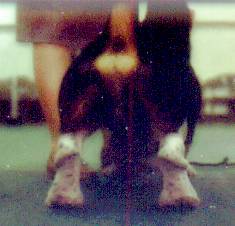
The hindquarters are very full and well rounded, and are approximately equal to the shoulders in width. They must not appear slack or light in relation to the over-all depth of body. The dog stands firmly on its hind legs showing a well-let-down stifle with no tendency toward a crouching stance. Viewed from behind, the hind legs are parallel, with the hocks turning neither in nor out. Cowhocks or bowed legs are serious faults. The hind feet point straight ahead. Steep, poorly angulated hindquarters are a serious fault. The dewclaws, if any, may be removed.
WHAT TO LOOK FOR:
Hindquarters that are strong, well-muscled and well rounded, neither narrower nor wider than the shoulders. Viewed from the rear, the muscles of the thighs should be so firm and prominent that they form a spherical mass, which is generally described as being ‘apple round'.
Looking from the side, the hindquarters should be deep and wide through the thigh. The legs are short from hock to foot, the hocks are well let down and well bent, and may have a pouch of loose skin on each one.
Bone size of hind legs is equivalent to that of the forelegs, and the height of the Basset at the hindquarters should be the same as the height at the shoulders.
The hind feet are generally not as massive as the front feet, and, when the dog stands naturally, they come well under the body and point straight ahead, unlike the front feet.
WHAT TO AVOID:
Any appearance in the hindquarters of being slack or light in bone or narrow. Cowhocks and bowed legs are serious faults. High hocks. Steep stifle. Crouching stance.
See the Hindquarter pictures of the Illustrated Standard
This depicts good hindquarters
with a nice apple round rear end - a feature which our Bassets are losing